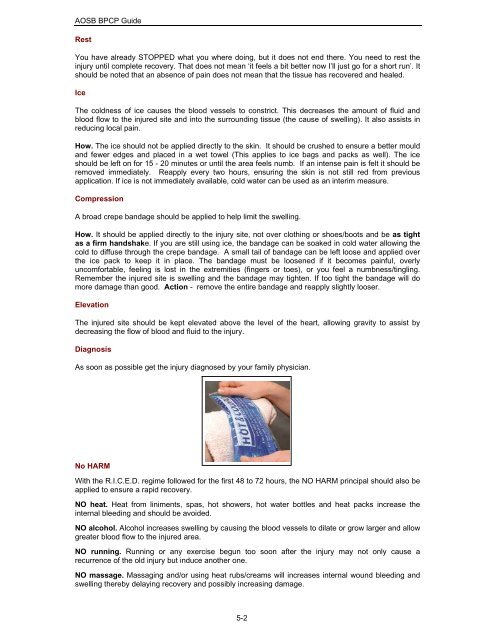Duntroon Army Officer Selection - Australian Army
Duntroon Army Officer Selection - Australian Army
Duntroon Army Officer Selection - Australian Army
Create successful ePaper yourself
Turn your PDF publications into a flip-book with our unique Google optimized e-Paper software.
AOSB BPCP Guide<br />
Rest<br />
You have already STOPPED what you where doing, but it does not end there. You need to rest the<br />
injury until complete recovery. That does not mean ‘it feels a bit better now I’ll just go for a short run’. It<br />
should be noted that an absence of pain does not mean that the tissue has recovered and healed.<br />
Ice<br />
The coldness of ice causes the blood vessels to constrict. This decreases the amount of fluid and<br />
blood flow to the injured site and into the surrounding tissue (the cause of swelling). It also assists in<br />
reducing local pain.<br />
How. The ice should not be applied directly to the skin. It should be crushed to ensure a better mould<br />
and fewer edges and placed in a wet towel (This applies to ice bags and packs as well). The ice<br />
should be left on for 15 - 20 minutes or until the area feels numb. If an intense pain is felt it should be<br />
removed immediately. Reapply every two hours, ensuring the skin is not still red from previous<br />
application. If ice is not immediately available, cold water can be used as an interim measure.<br />
Compression<br />
A broad crepe bandage should be applied to help limit the swelling.<br />
How. It should be applied directly to the injury site, not over clothing or shoes/boots and be as tight<br />
as a firm handshake. If you are still using ice, the bandage can be soaked in cold water allowing the<br />
cold to diffuse through the crepe bandage. A small tail of bandage can be left loose and applied over<br />
the ice pack to keep it in place. The bandage must be loosened if it becomes painful, overly<br />
uncomfortable, feeling is lost in the extremities (fingers or toes), or you feel a numbness/tingling.<br />
Remember the injured site is swelling and the bandage may tighten. If too tight the bandage will do<br />
more damage than good. Action - remove the entire bandage and reapply slightly looser.<br />
Elevation<br />
The injured site should be kept elevated above the level of the heart, allowing gravity to assist by<br />
decreasing the flow of blood and fluid to the injury.<br />
Diagnosis<br />
As soon as possible get the injury diagnosed by your family physician.<br />
No HARM<br />
With the R.I.C.E.D. regime followed for the first 48 to 72 hours, the NO HARM principal should also be<br />
applied to ensure a rapid recovery.<br />
NO heat. Heat from liniments, spas, hot showers, hot water bottles and heat packs increase the<br />
internal bleeding and should be avoided.<br />
NO alcohol. Alcohol increases swelling by causing the blood vessels to dilate or grow larger and allow<br />
greater blood flow to the injured area.<br />
NO running. Running or any exercise begun too soon after the injury may not only cause a<br />
recurrence of the old injury but induce another one.<br />
NO massage. Massaging and/or using heat rubs/creams will increases internal wound bleeding and<br />
swelling thereby delaying recovery and possibly increasing damage.<br />
5-2

















